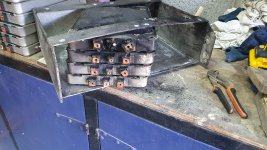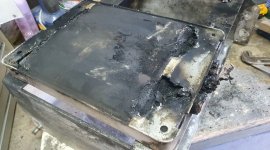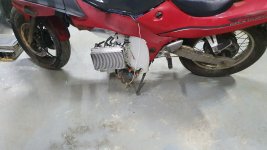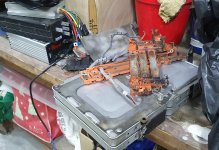marcexec
1 kW
Thermal event!
So, due to stupidly ignoring a lower voltage readout on a cell and a combination of overconfidence and long term moisture damage I got once of the cells to reverse or internally short during operation (120km/h speed test with new controller, see Lebowski thread), destroying a module. I had previously attributed the lower readout to a wonky connection from the balance lead, big mistake.
No thermal runway, the remaining modules are fine as far as I can tell. The AESC modules are quite safe luckily.
The only damage was to the plexiglass cover and the aluminium bar (660°C melting point!) where it vented plus some soot.
I just got the bike back together as I also moved the fuse box and changed for a shielded cable on the primary positive connection.
Down to 34S, but in time for the meetup tomorrow: DIY Electric Vehicle Meetup – Tog Hackerspace
Keep in mind the modules are 12 years old by now and most have been outside on the bike with little protection since the 80100 experiments and then used daily since 2017. Seal your battery boxes, guys!








So, due to stupidly ignoring a lower voltage readout on a cell and a combination of overconfidence and long term moisture damage I got once of the cells to reverse or internally short during operation (120km/h speed test with new controller, see Lebowski thread), destroying a module. I had previously attributed the lower readout to a wonky connection from the balance lead, big mistake.
No thermal runway, the remaining modules are fine as far as I can tell. The AESC modules are quite safe luckily.
The only damage was to the plexiglass cover and the aluminium bar (660°C melting point!) where it vented plus some soot.
I just got the bike back together as I also moved the fuse box and changed for a shielded cable on the primary positive connection.
Down to 34S, but in time for the meetup tomorrow: DIY Electric Vehicle Meetup – Tog Hackerspace
Keep in mind the modules are 12 years old by now and most have been outside on the bike with little protection since the 80100 experiments and then used daily since 2017. Seal your battery boxes, guys!










